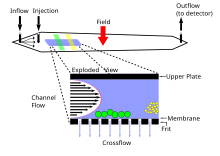Asymmetric flow field flow fractionation
The Asymmetric Flow Field-Flow Fractionation (AF4 / AFFFF, Eng. Asymmetric flow field-flow fractionation ), often called "asymmetric flow field flow ", is a young separation method for the fractionation and analysis of materials . It is a variant of field-flow fractionation (FFF).
In certain molar mass ranges (approx. 1 kDa –10 MDa), AF4 is complementary to size exclusion chromatography (GPC / SEC). While in the SEC the separation takes place due to the interactions with a porous stationary phase, which are dependent on the molecular size , in the FFF a field is used perpendicular to the direction of flow. With the FFF it is possible to analyze not only charged and uncharged polymers , aggregates and proteins, but also viruses . Separations take place in a range from about 1 nm to 100 µm.
The detection of the eluted analytes is carried out using UV spectrometers , refractive index detectors and light scattering detectors. The coupling of the AF4 with multiangle laser light scattering ( MALLS ) allows the analysis of particle sizes without using size standards.
The advantage of the FFF over the SEC is its speed, the lack of shear forces and interactions with the stationary phase and the dynamic separation range. The separation is gentle and high-resolution. Analytes can be dissolved or dispersed.
Individual evidence
- ↑ Evelin Moldenhauer, Thorsten Klein: field flow fractionation - separation and characterization of proteins, polymers and particles . Chemie.de, accessed on April 16, 2013.
